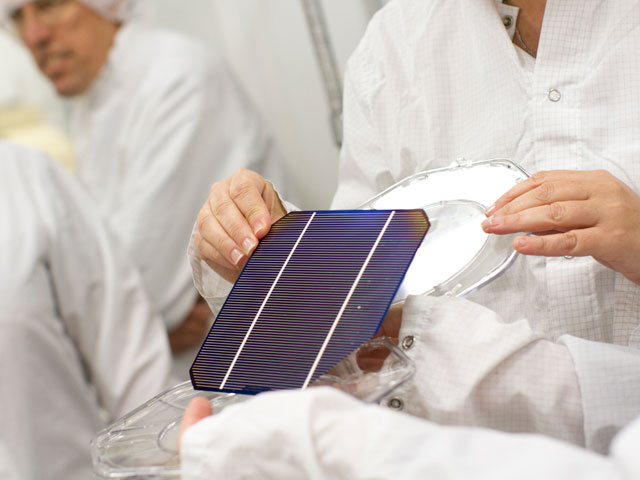
Our research: Energy

The urgency to discover and deploy new forms of carbon-reducing energy technologies has become an irrefutable part of our economic and environmental landscape. Our research in renewable and alternative energy sources is multifaceted with efforts in solar and photovoltaic energy, biotechnology, low- and high-power energy storage, power electronics, electric power system, batteries and hydrogen fuel cells.
ASU leading solar research, commercialization through NSF-DOE Engineering Research Center

Christiana Honsberg, professor, School of Electrical, Computing and Energy Engineering, will lead the multi-institution consortium, QESST.
ASU is leading a new national Engineering Research Center (ERC) supported jointly by the National Science Foundation (NSF) and Department of Energy (DOE) to solve challenges to harnessing solar power in economically viable and sustainable ways.
The ERC for Quantum Energy and Sustainable Solar Technologies—or QESST—is led by faculty at ASU, including center director, Christiana Honsberg, professor in the School of Electrical, Computer and Energy Engineering, along with faculty from partner institutions: California Institute of Technology, Massachusetts Institute of Technology, University of Delaware and University of New Mexico.
The NSF and DOE will jointly provide funding of $18.5 million for the first five years of the center’s operations.
The center’s mission includes accelerating commercialization of solar energy technologies through partnerships with industry and expanding opportunities for education in energy engineering.
Engineering Research Centers—sponsored by the NSF—focus on areas of research considered vital to national interests in science and engineering innovation, technological advancement, economic expansion and education of future innovation leaders.
“An expanding global economy is bringing an unquenchable demand for more electrical power. It will become vital to progress throughout the 21st century to have the benefits of alternative energy sources that solar power can provide through photovoltaic technologies,” said Honsberg, who also directs ASU’s Solar Power Lab.
Beyond enabling collaborations among university research teams, the center will bring universities, major energy companies, photovoltaics industry leaders and entrepreneurs together in partnerships. Another component of the center’s mission is to improve engineering education and expand the community that is engaged in energy research and education.
Along with pursuing advances to increase the efficiency of photovoltaic devices for converting sunlight into electrical energy, researchers will develop new manufacturing processes to produce photovoltaic solar power systems at an unprecedented scale that can be integrated into the nation’s power grid for widespread energy distribution.
The overriding goal of the endeavor is to enable photovoltaic technologies to be capable of supplying a majority of new electricity generation in the United States within a decade, as well as providing power for up to 1.5 billion people worldwide who now have little or no access to electrical energy.
PSERC awarded $5.5 million to transform the energy system grid
The Power Systems Energy Research Center (PSERC) at Arizona State University has been awarded a $5.5 million grant from the Department of Energy to investigate requirements for a systematic transformation of today’s electric grid.
The future grid needs to support high penetrations of highly variable distributed energy resources mixed with large central generation sources, energy storage, and responsive users equipped with embedded intelligence and automation. These sustainable energy systems require more than improvements to the existing system; they require transformative changes in planning and operating electric power systems.
Vijay Vittal, director of PSERC and Ira A. Fulton Chair in Electrical Engineering at ASU is leading a multidisciplinary, multi-university team to investigate these challenges and to seek solutions to achieve the needed transformation.
To date, the energy system architecture has been a hierarchically-connected network with tightly synchronized energy resources. The envisioned system is going to be very different. It will be more complex, heterogeneous and dynamic. The operating environment will be more uncertain due in part to the variability of renewable energy production, to diverse and distributed operating objectives, and to greater reliance on customer responsiveness to maintain power system reliability.
PSERC will be investigating innovations in network architectures; planning approaches; operation, control and protection paradigms; computational and analysis challenges; carbon policy implications; customer response programs; and resilient cyber-physical systems.
PSERC will also develop educational resources to ensure that the existing and future power and energy engineering workforce can enable a high penetration of sustainable energy systems by envisioning the requirements of the future energy system, and designing, planning, manufacturing, building and operating the diverse energy systems.
New material can enhance energy, computer, lighting technologies
Arizona State University researchers have created a new compound crystal material that promises to help produce advances in a range of scientific and technological pursuits.
ASU electrical engineering professor Cun-Zheng Ning says the material, called erbium chloride silicate, can be used to develop the next generations of computers, improve the capabilities of the Internet, increase the efficiency of silicon-based photovoltaic cells to convert sunlight into electrical energy, and enhance the quality of solid-state lighting and sensor technology.
Ning and his team are now trying to use the new erbium compound for various applications, such as increasing silicon solar cell efficiency and making miniaturized optical amplifiers for chip-scale photonic systems for computers and high-speed Internet.
NSF CAREER Award for Shrivastava
Aviral Shrivastava, an assistant professor in the School of Computing, Informatics, and Decision Systems Engineering, was awarded an NSF CAREER award to support his research on reliable computing.
Shrivastava says, “At the time our reliance on computing systems is at its greatest, computing hardware is beginning to become unreliable. Cosmic particles, e.g., neutrons floating around in the environment, may strike a transistor, and switch its logic state. This can have dire consequences, from spectacular program and system crashes, to subtle wrong results. As the transistor sizes are shrinking, even low-energy particle strike can cause an error.”
“Even though the hardware is fundamentally becoming more susceptible to such ‘soft errors,’ we still want to keep our computation correct,” he says. Shrivastava and his team of students are developing compiler techniques which will detect and compensate for such errors, and provide reliable computation on reliable hardware.




































